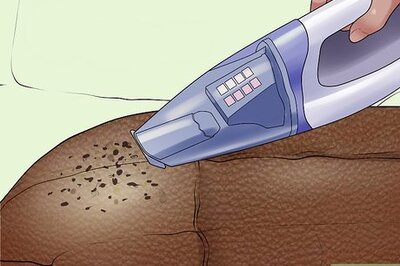
views
What is ninjutsu?
Cards with ninjutsu can be cheated into play with unblocked attackers. Ninjutsu is an alternate casting ability that is only relevant after attackers and blockers are declared, but before the combat steps have ended. To use ninjutsu, you pay the ninjutsu cost, remove an unblocked creature from combat, and put the card with ninjutsu onto the battlefield, attacking. Ninjutsu is basically a fancy version of flash. If you find yourself confused by the mechanic, just imagine it’s flash, but you replace an attacking, unblocked creature. Ninjutsu was first introduced in the Kamigawa block. It appears exclusively on ninja creatures and is meant to mimic the feeling of a sneak attack. Ninjutsu is primary in blue and black, although there are two green cards and one white card with the ability.
An Example of Ninjutsu
You have two creatures in play, your opponent has one. Let’s say you have an Elvish Mystic and a Grizzly Bear in play. Your opponent only has a Wall of Omens.
You attack with both creatures. You move to combat and turn the Bear and Elf sideways to tap them and say “I’m attacking with both creatures.”
Your opponent declares blockers. Since you have two creatures to your opponent’s one, something on your side is going to get through. Since the Bear is a 2/2, your opponent puts the Wall in front of it. Nothing is blocking the Elvish Mystic.
Before damage, you cast your ninjutsu card. You say “before damage” to let your opponent know you have actions to take. You tap the ninjutsu mana and cast your ninjutsu card. At the same time, you return the Elvish Mystic to your hand. You put the ninjutsu creature in the attacking position. You can cast ninjutsu cards normally, but you only pay the ninjutsu cost when you’re casting the card using the ability. It is not an additional cost (like Kicker).
Any ninjutsu ETB effects occur. Most ninjutsu cards have some kind of added benefit or effect that occurs when you use the ninjutsu ability. If the ninjutsu card has an enter-the-battlefield (ETB) effect, it goes on the stack immediately. An example is Azra Smokeshaper. When it enters the battlefield, you choose a creature you control to become indestructible.
Damage occurs and any combat damage effects occur. Many of the ninjutsu cards get to do something powerful when they deal combat damage to a player. If a ninjutsu card has a “Whenever X deals combat damage to a player, that player…” ability, this occurs after damage. An example here would be Coiling Stalker. When it deals damage to a player, you put a +1/+1 counter on a creature you control.
Ninjutsu Rules
Ninjutsu does not use the stack. Normally, when you cast a card, your opponent gets the opportunity to respond. Ninjutsu doesn’t actually use the stack though, so your opponent will never have a window to reply. The official text of ninjutsu reads, “Return an unblocked attacker you control to hand: Put this card onto the battlefield from your hand tapped and attacking.” Note that the word “cast” does not appear here! This means the ninjutsu creature is in play before priority passes.
You cannot counter ninjutsu. Because it doesn’t use the stack, ninjutsu creatures cannot be countered by cards like Mana Leak, Counterspell, or Cancel.
You cannot change attack targets for ninjutsu creatures. If the creature you return to your hand was attacking an opponent’s planeswalker, your ninjutsu creature must attack the same planeswalker. The same goes if they were attacking the player instead—the ninjutsu creature must also attack the player. You cannot change the attack.
Best Ninjutsu Cards
Fallen Shinobi Fallen Shinobi is a powerful and iconic ninjutsu payoff card that allows you cast cards from the top of your opponent’s deck for free. As a result, Shinobi sees a little bit of play in legacy and vintage—formats where opponents have cards like Emrakul, the Promised End and Griselbrand in their decks. Fallen Shinobi is the only ninjutsu card to see play regularly in eternal formats (outside of pauper). It is widely considered to be the single most powerful ninjutsu card. Fallen Shinobi is also a popular inclusion in vintage, legacy, or power cubes.
Ninja of the Deep Hours Ninja of the Deep Hours is a pauper staple. It deals you a card every time it deals combat damage to a player, and “draw a card” are the three most powerful words you can put on an MTG card, so it sees a good bit of play in common-only formats. Ninja of the Deep Hours is a common inclusion in any blue pauper deck that cares about tempo.
Ingenious Infiltrator If you’re going to build a ninja tribal deck, Ingenious Infiltrator is one of the best payoffs. It buffs all of your ninjas to give them Ninja of the Deep Hours’ “draw a card” ability. If you can build out a substantive board, the Infiltrator can draw you 2-4 cards a turn, if not more. You’re likely building a ninja tribal deck in EDH, but there’s a legacy ninja deck that sees some fringe play.
What is commander ninjutsu?
Commander ninjutsu is just ninjutsu for EDH commanders. It’s technically a different keyword because it doesn’t use the exact same language as the vanilla “ninjutsu” mechanic. The only difference is that commander ninjutsu says “…put this card onto the battlefield from your hand or the command zone tapped and attacking.” The mechanic functions the same way as ninjutsu for mechanical purposes. Commander ninjutsu only appears on one card—Yuriko, the Tiger's Shadow. Yurkio is basically the default commander option if you want to build a ninja EDH deck.



















Comments
0 comment